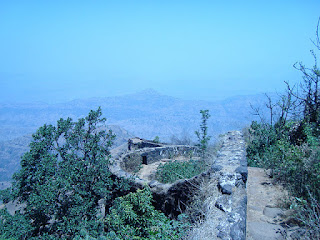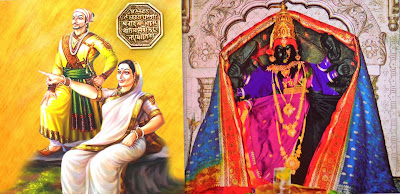I know that people have spent their lifetimes as historians and researchers; and yet their pursuit to know more and more about the legacy of Chh. Shivaji Maharaj continues.
This here is just a trivial attempt to understand, acknowledge and describe some of the exemplary qualities of Shivaji Maharaj as a king, as a military leader, as a strategist and as a visionary through views and opinions expressed by some of the prominent historians and personalities.
Frankly speaking I was falling short of words to describe the greatness of Chh. Shivaji Maharaj and hence, in this blog I have decided to borrow words from others. This is my humble tribute to the great Shivaji.
In words of the famous historian Setu Madhavrao Pagadi, "Shivaji is one of the great national figures of India. As a Soldier, Warrior and General, Shivaji fashioned the army into a truly national one. Perfect discipline, rapid movements, excellent intelligence service and continuous attention to the defence marked his military organization, and this enabled him to defeat his adversaries time and again. He did not neglect the defense of the Sea Coast and is rightly called the father of the Indian Navy."
Swami Vivekananda remarks "Is there a greater hero, a greater saint, a greater bhakta and a greater king than Shivaji? Shivaji was the very embodiment of a born ruler of men as typified in our great epics. He was the type of the real son of India representing the true consciousness of the nation. It was he who showed what the future of India is going to be sooner or later."
If we go back a little in time, the great saint Tukaram referred to his reign as "Ram Rajya" and his spiritual guru and ally Samarth Ramdas reverred him to be "Shrimant Yogi" - A person who has it all, but at the same time has a power to remain detached to his belongings and use them for the greater good of mankind.
And if you feel there are too many hindu names and references I have given out, here is what Khafi Khan, a contemporary Moghul historian had to say about Shivaji Maharaj in his book Muntakhab-ul-Lubab : "Shivaji had always strived to maintain the honor of the people in his territories, and was careful to maintain the honor of women and children of Muhammadans when they fell into his hands. His injunctions on this matter are very strict."
Another contemporary historian Bhimsen writes in Tarikh-i-Dilkasha, "He was a straight-forward man and a matchless soldier and knew the administrative side of the king-ship very well. He enjoyed full confidence of this soldiers."
In words of famous historian sir J.N.Sarkar, "States fall, empires break up, dynasties become extinct - but the memory of a true 'hero as King' like Shivaji, remains an imperishable historical legacy for the entire human race."
Those, my readers were just a few words about Shivaji - his greatness, his secularism, his respect for human-beings, his care and affection for his soldiers, his leadership, his administration, his strategies, his rule, his life!!
In the next chapter, we will explore some of these qualities and leadership attributes, particularly the ones which gave Shivaji an upper hand during the course of events, leading to the Pratapgad Battle.
Also, we will take a sneak peak at the extent of Shivaji Maharaj's Kingdom during the time of Afzalkhan's attack - thereby making ourselves ready to start discussing the raid of Afzalkhan and the battle of Pratapgad itself.
This here is just a trivial attempt to understand, acknowledge and describe some of the exemplary qualities of Shivaji Maharaj as a king, as a military leader, as a strategist and as a visionary through views and opinions expressed by some of the prominent historians and personalities.
Frankly speaking I was falling short of words to describe the greatness of Chh. Shivaji Maharaj and hence, in this blog I have decided to borrow words from others. This is my humble tribute to the great Shivaji.
In words of the famous historian Setu Madhavrao Pagadi, "Shivaji is one of the great national figures of India. As a Soldier, Warrior and General, Shivaji fashioned the army into a truly national one. Perfect discipline, rapid movements, excellent intelligence service and continuous attention to the defence marked his military organization, and this enabled him to defeat his adversaries time and again. He did not neglect the defense of the Sea Coast and is rightly called the father of the Indian Navy."
Swami Vivekananda remarks "Is there a greater hero, a greater saint, a greater bhakta and a greater king than Shivaji? Shivaji was the very embodiment of a born ruler of men as typified in our great epics. He was the type of the real son of India representing the true consciousness of the nation. It was he who showed what the future of India is going to be sooner or later."
If we go back a little in time, the great saint Tukaram referred to his reign as "Ram Rajya" and his spiritual guru and ally Samarth Ramdas reverred him to be "Shrimant Yogi" - A person who has it all, but at the same time has a power to remain detached to his belongings and use them for the greater good of mankind.
And if you feel there are too many hindu names and references I have given out, here is what Khafi Khan, a contemporary Moghul historian had to say about Shivaji Maharaj in his book Muntakhab-ul-Lubab : "Shivaji had always strived to maintain the honor of the people in his territories, and was careful to maintain the honor of women and children of Muhammadans when they fell into his hands. His injunctions on this matter are very strict."
Another contemporary historian Bhimsen writes in Tarikh-i-Dilkasha, "He was a straight-forward man and a matchless soldier and knew the administrative side of the king-ship very well. He enjoyed full confidence of this soldiers."
In words of famous historian sir J.N.Sarkar, "States fall, empires break up, dynasties become extinct - but the memory of a true 'hero as King' like Shivaji, remains an imperishable historical legacy for the entire human race."
Those, my readers were just a few words about Shivaji - his greatness, his secularism, his respect for human-beings, his care and affection for his soldiers, his leadership, his administration, his strategies, his rule, his life!!
In the next chapter, we will explore some of these qualities and leadership attributes, particularly the ones which gave Shivaji an upper hand during the course of events, leading to the Pratapgad Battle.
Also, we will take a sneak peak at the extent of Shivaji Maharaj's Kingdom during the time of Afzalkhan's attack - thereby making ourselves ready to start discussing the raid of Afzalkhan and the battle of Pratapgad itself.




























